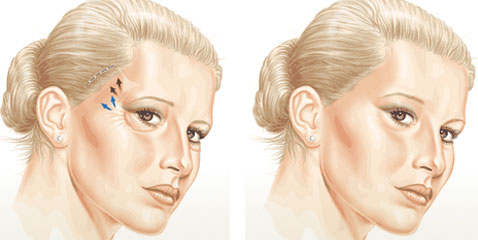Plastic surgeon Dr Felix Paprottka loves restoring drooping brows to their youthful position. He explains how he does it using a combination of procedures; lateral brow lift and upper blepharoplasty.
What is your favourite procedure to perform?
I personally like the lateral brow lift in combination with an upper blepharoplasty (upper eyelid correction). Patients with a long forehead, at some point in their life, will face the problem that their brows look droopy. These patients will always look a bit tired because of their heavy brows — meaning the lateral sides of their brows are hanging down and there is an excess of skin in the upper eyelid area. Sometimes this look can be even more visible after a Injectables treatment in the forehead area, which makes the muscles relax even more.
Many surgeons treat this appearance with just an upper blepharoplasty, removing only the skin in the upper eyelid area. By doing this, the distance between the brow and the upper eyelid becomes shorter and shorter with every surgical procedure and it starts to look unnatural. Also, the problem with the hanging brow has not been solved by this attempt. By carrying out a lateral brow lift with an upper blepharoplasty, the excess skin is removed and the outside tail of the eyebrows is lifted. This not only helps to correct hooded eyelids and smooth crow’s feet but also creates the appearance of sexy, foxy eyes.
Why do you like performing lateral brow lift and upper blepharoplasty?
I am a big fan of it because the natural position of the brows can be restored by this procedure. In order to restore the brows, the plastic surgeon first lifts the lateral brow area and, thereafter, removes the left-over skin in the upper eyelid area. When combining these two procedures, it’s very important to start with the lateral brow lift, since then the surgeon can actually see how much skin needs to be resected in the upper eyelid area.
I also like this intervention as it can be easily performed under sedation. This means the patient receives some intravenous medication in order to feel sleepy and relaxed but is breathing on her/his own. They mostly cannot remember anything about the procedure when they wake up. If a patient wishes to have this procedure performed with local anaesthesia only, this can be offered as well.
How many times have you done lateral brow lift and upper blepharoplasty?
This is a procedure we perform at least once every two weeks in Ocean Clinic.
How are lateral brow lift and upper blepharoplasty surgery carried out?
For the lateral brow lift, a 2 cm horizontal cut is applied in the hairline around the temples. This is an area where women do not lose any hair while ageing so the scar is well hidden. Via this access, the lateral brow is moved upwards by applying an interlocking suture. The same result is reproduced on the contralateral side and the wounds are closed with staples (staples are used since they can be removed almost painlessly in the hair region after 10 days following surgery.)
Next, a fine skin resection is performed, removing the left-over skin in the upper eyelid region. The scar is placed in the tarsal fold, so it’s almost invisible. In general, scars in the face heal very well. With these two combined interventions, the tired look from which many patients suffer can be resolved and corrected. I am always amazed by the great results we can achieve!
What’s the most technical part of lateral brow lift and upper blepharoplasty surgery?
The most technical part of the lateral brow lift is placing the interlocking suture. It functions as a pulley block; with one suture, the deep fascia is grabbed and with the other part, the overlaying skin is pulled upwards. As a result, the lateral part of the brow can be lifted nicely, resulting in a “V” shaped brow area.
The challenging part of an upper blepharoplasty is to resect the skin in such a manner that the scar is placed directly in the existing tarsal fold and therefore is not visible. But since we do these surgeries very frequently these surgical steps are not difficult for us.
Have there been any changes in the technique or technology used in this procedure?
In the beginning, some plastic surgeons performed a full forehead-lift. This results in a long horizontal scar, which is placed in the hairline transition zone. This technique can be used if the medial part of the brow is also drooping and needs to be lifted. But for most patient cases with just a lateral drooping brow, the lateral brow lift is the best treatment option. An endoscopic technique can be applied when it makes sense, resulting in even smaller scars.

How might lateral brow lift and upper blepharoplasty surgery change in the future?
This technique has already been improved over a long period of time and really works very well. So we do not expect major changes in the future.
Do you have any memories that stand out in relation to this procedure or the patients you’ve carried it out on?
Yes, all of my patients are always very happy and excited directly after the surgery, since the new V-shaped position of the brows is immediately visible.
Tired of looking tired? Make an appointment to find out more about lateral brow lift and upper blepharoplasty surgery. Both in-clinic and online video consultations are available.


